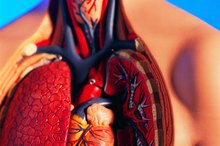What does fact checked mean?
At Healthfully, we strive to deliver objective content that is accurate and up-to-date. Our team periodically reviews articles in order to ensure content quality. The sources cited below consist of evidence from peer-reviewed journals, prominent medical organizations, academic associations, and government data.
The information contained on this site is for informational purposes only, and should not be used as a substitute for the advice of a professional health care provider. Please check with the appropriate physician regarding health questions and concerns. Although we strive to deliver accurate and up-to-date information, no guarantee to that effect is made.
Why Can I Feel My Heartbeat in My Stomach?
Some people experience what feels like a heartbeat or pulse in their abdomen at some point. This is your abdominal aorta pulsating. It can be a normal feeling in healthy people, especially people who are very slim, but in some people it can also be a sign of a serious health condition, called an abdominal aortic aneurysm, or AAA 34. If you have concerns about this symptom, ask you doctor -- and you have other symptoms, such as severe or persistent pain in your abdomen or back, seek immediate medical attention or call 911.
If you are experiencing serious medical symptoms, seek emergency treatment immediately.
The Abdominal Aorta
The abdominal aorta is a major artery that carries blood, oxygen and nutrients from your heart to other parts of your body. It is located to the left of the spine, between the chest and navel.
A Heartbeat Feeling
Can You Feel Your Baby's Heartbeat in Your Stomach?
Learn More
You can sometimes feel the pulse of the abdominal aorta, what feels like a heartbeat, by pressing into your abdomen above the navel. You may also feel it at other times or in certain positions, such as lying on your stomach. Thin people are more likely to notice this feeling, due to less abdominal fat.
Abdominal Aortic Aneurysm
A heavy pulsating of the abdominal aorta could be a sign of an abdominal aortic aneurysm 34. This is caused by a weak spot in the wall of the artery, which then bulges out. In addition to a pulsing sensation, your doctor might notice a lump or mass in the abdomen, or your doctor might notice that your abdomen feels rigid. It's important to diagnose and treat an AAA before it ruptures, so if you suspect you might have one, see your doctor.
- A heavy pulsating of the abdominal aorta could be a sign of an abdominal aortic aneurysm 3.
- It's important to diagnose and treat an AAA before it ruptures, so if you suspect you might have one, see your doctor.
Who's at Risk?
My Heart Goes Out of Rhythm When I Squat
Learn More
According to PubMEd Health, abdominal aortic aneurysms are more common among men over 60 years old who have certain other risk factors, including high blood pressure and smoking 14. There may be certain genetic risk factors as well.
Related Articles
References
- Health Central: Aortic Aneurysms
- Society of Interventional Radiology: Abdominal Aortic Aneurysm Diagnosis and Treatment Options
- MedicineNet.com: Abdominal Aortic Aneurysm
- Medscape: Abdominal Aortic Aneurysm
- US National Library of Medicine. Medline Plus. Thoracic aortic aneurysm
- Stanford Health Care. What are the symptoms of an abdominal aortic aneurysm?
- American Heart Association. What are the Symptoms of an Aortic Emergency?
- Cleveland Clinic. What are the symptoms of aortic dissection?
- US National Library of Medicine. Medline Plus. Aortic regurgitation
- Hiratzka LF, Bakris GL, Beckman JA, et al. 2010 ACCF/AHA/AATS/ACR/ASA/SCA/SCAI/SIR/STS/SVM Guidelines For The Diagnosis And Management Of Patients With Thoracic Aortic Disease: a Report of the American College of Cardiology Foundation/American Heart Association Task Force on Practice Guidelines, American Association for Thoracic Surgery, American College of Radiology, American Stroke Association, Society of Cardiovascular Anesthesiologists, Society for Cardiovascular Angiography and Interventions, Society of Interventional Radiology, Society of Thoracic Surgeons, and Society for Vascular Medicine. Circulation 2010; 121:e266.
- Moll FL, Powell JT, Fraedrich G, et al. Management Of Abdominal Aortic Aneurysms Clinical Practice Guidelines Of The European Society For Vascular Surgery. Eur J Vasc Endovasc Surg 2011; 41 Suppl 1:S1.
Writer Bio
James Gilmore has written professionally since 2005. Since then, he has written and proofread obituaries for "The Press & Sun-Bulletin" in Binghamton, N.Y., press releases for "Goals, Seminars and Consultants" and articles for Made Man and various other websites. He writes a good deal of music-related content and holds a Bachelor of Arts in journalism from Ithaca College.








